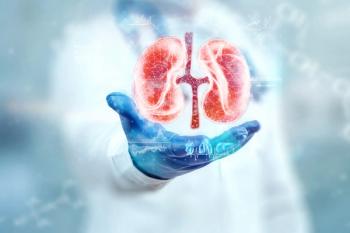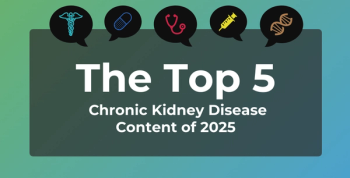
Results From FIGARO-DKD: Finerenone’s Impact on Type 2 Diabetes and CKD
Rajiv Agarwal, MD, MS, shares expert insight on the results of FIGARO-DKD with respect to the trial’s primary and secondary end points.
Episodes in this series

Transcript:
Rajiv Agarwal, MD, MS: The primary end point in the FIGARO-DKD study was the 4-point MACE [major adverse cardiac event], which is described as CV death, or cardiovascular death; nonfatal MI [myocardial infarction]; nonfatal stroke; or a hospitalization for heart failure. The key secondary end point was renal outcome, which is defined as a 40% decline in eGFR [estimated glomerular filtration rate] from baseline confirmed within 30 days; kidney failure, which is either dialysis or transplantation or eGFR persistently reduced to less than 15; or death from renal disease. Basically, we have cardiovascular outcome as the primary outcome. Before I tell you the results, I can tell you that the typical patient in the study had diabetes for 14-and-a-half years and was 64 years old; 70% of patients were men. The mean systolic blood pressure was 136/77 mm Hg. Everybody was on an ACE [angiotensin-converting enzyme inhibitor] or an ARB [angiotensin receptor blocker]. Cardiovascular disease was present in 45% of patients, and 7.8% of the population had a history of heart failure. On top of that, 71% of patients were on statins. That’s an incredibly well-treated population, especially when 8.4% of these patients were on an SGLT2 inhibitor and 7.5% were on GLP-1 receptor agonist therapy.
These are incredibly well-treated patients, and we are asking, given this individual, can we use finerenone versus a placebo? Will that reduce cardiovascular events? The answer was that we absolutely reduce the risk of cardiovascular outcome by 13%, a relative risk reduction of 13%. The P value is .026, and the number needed to treat after 3-and-a-half years of exposure to this medicine to prevent 1 cardiovascular outcome—the primary outcome we defined in this trial—was 47. This was a very robust result given that the only reason these patients have been identified as having a high cardiovascular risk was not because they have poorly controlled hypertension or poorly controlled diabetes, are smokers, or have dyslipidemia. The sole reason is because they have kidney disease, and the majority of these people have an eGFR in the silent zone of more than 60. We are identifying them on the basis of albuminuria.
This is really a landmark finding in this trial. Given the fact that if you look at the components of the end point—the atherosclerotic events, for example, MI or stroke—they’re not as much effected. It’s primarily driven for hospitalization for heart failure. That’s a big deal because in these patients who are hospitalized for heart failure, the mortality is enormous, the cost to the society is enormous, and the progression to future end-stage renal disease is enormous. We’ve cut the risk of hospitalization for heart failure by 29%. The hazard ratio is 0.71 with a P value of .004, and that was a big deal in this trial. Cardiovascular deaths were reduced by about 10%, which is not statistically significant, but hospitalization for heart failure was the big story in the study.
The secondary end point that we had in this trial was the kidney end point, and that was defined as a 40% reduction in eGFR, kidney failure, or death from renal causes. The hazard ratio here was 13%, just like the cardiovascular outcome. However, the upper bound of the confidence interval was 1.01, which gives us a P value of .069. Nominally, this end point wasn’t met. However, let’s look at it a little deeper, because 40% is a novel end point that we have started using in patients with diabetes and kidney disease. It’s not the typical end point that we have used in the past. In the captopril study published in 1993, it was a doubling of serum creatinine. In the 2 landmark trials with an ARB, called IDNT and RENAAL, it was a doubling of serum creatinine. In the CREDENCE trial, which was with canagliflozin in patients with kidney disease and macroalbuminuria, it was doubling of serum creatinine. Doubling of serum creatinine is approximately a 57% decline in eGFR. If you look at that end point, which was a key secondary end point in FIGARO, there was a 23% reduction in the risk of the outcome, so you have a hazard ratio of 0.77 with a P value of .041. You basically have the upper bound of the hazard ratio as 0.99.
Statistically, it’s significant. But just to point this out, the results are internally consistent with the FIDELIO-DKD trial, because it shows a renal benefit provided that we use a more conventional end point rather than the more novel end point. The most important outcome to a patient with kidney disease is going on dialysis. If you go on dialysis and have type 2 diabetes, mortality is very similar to metastatic colon cancer. Here in the FIGARO trial, the hazard ratio is 0.64, so we have a 36% relative risk reduction in end-stage renal disease in this population. The P value is significant at .046, so we have a very robust finding, especially when we use the more sensible end points of end-stage kidney disease or 57% decline in eGFR composite.
The other signal that we have in the FIGARO trial is that of hyperkalemia. We have a small signal for hyperkalemia. About 1.2% of the patients permanently discontinued the study drug. We have over 7000 patients, and 46 in the finerenone arm permanently discontinued the drug versus 13 in the placebo group. So, 0.4% versus 1.2%. Look at it another way: almost 99% of the patients who are prescribed this drug will continue on the drug for a very long time. They won’t permanently discontinue the study drug because of hyperkalemia. Yes, hyperkalemia is going to occur because it’s an MRA [mineralocorticoid receptor antagonist]. It’s going to occur in people who have type 2 diabetes and kidney disease. We expect this to happen, but it’s manageable, and it’s a low risk. But we are saving hearts and we are saving kidneys, and that’s really the message of FIGARO, so let’s not get let down by the hyperkalemia signal and say that we shouldn’t be using the drug because of hyperkalemia. We should be using it because we can save hearts, we can save kidneys, and the hyperkalemia signal is manageable.
Transcript edited for clarity.
Newsletter
Stay ahead of policy, cost, and value—subscribe to AJMC for expert insights at the intersection of clinical care and health economics.








































